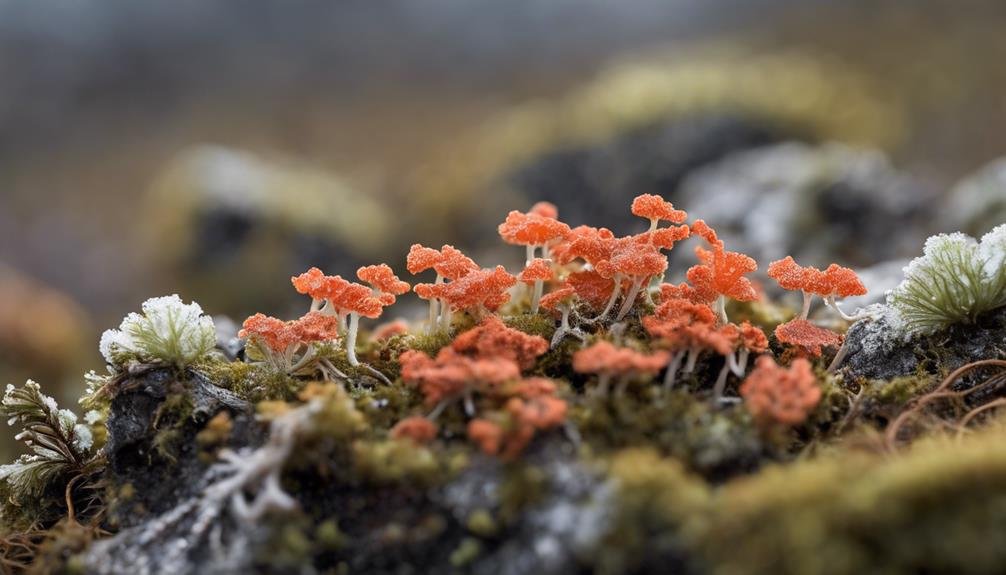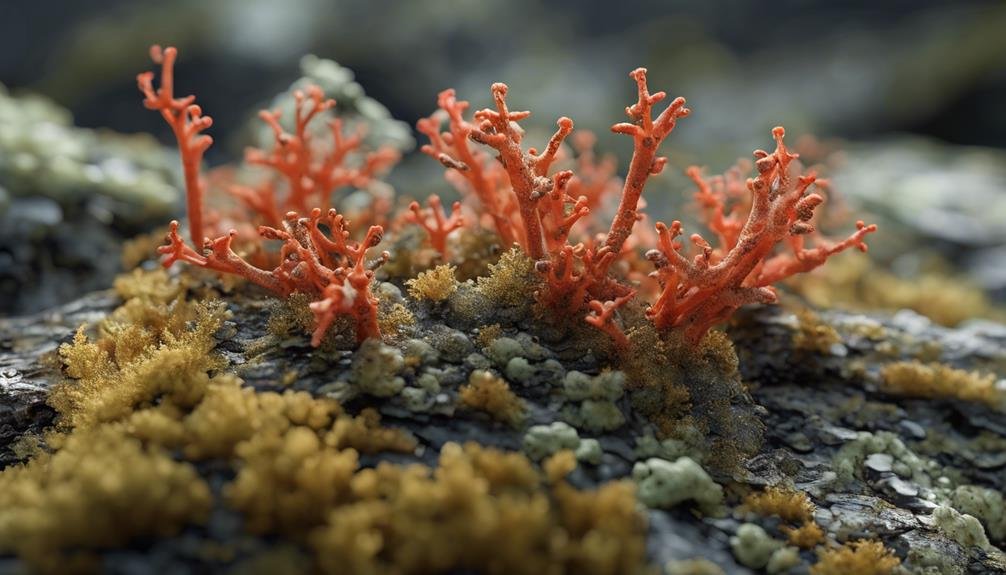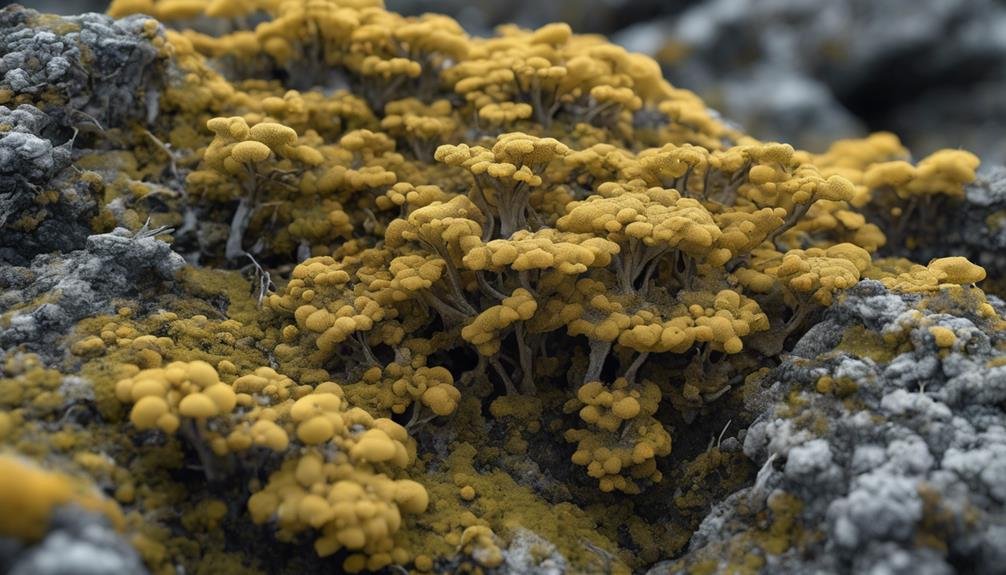Have you ever wondered what sustains the Arctic’s unique wildlife during the long, harsh winters? At the heart of this frigid ecosystem lies the Reindeer Lichen (Cladonia rangiferina), a crucial yet delicate player in the survival of Arctic fauna.
Covering up to 8% of some Arctic regions, Reindeer Lichen is pivotal to the tundra ecosystem. With its slow growth rate of 3 to 5 mm a year, it highlights both its fragility and the slow pace at which the Arctic environment changes.
Thriving in high humidity and cool temperatures, Reindeer Lichen not only supports itself but also serves as a vital food source for animals such as reindeer and caribou. However, the shifting climate poses significant threats to its sustainability and, by extension, to the entire Arctic food web.
This situation raises necessary discussions on how to protect Reindeer Lichen and maintain Arctic biodiversity.
Key Takeaways
Key Takeaways:
- Reindeer Lichen is a crucial part of the Arctic tundra ecosystem, vital for caribou diets and indigenous communities.
- It faces threats from climate change, impacting its growth rate and potentially its survival and the ecosystem.
- Conservation efforts are necessary to protect Reindeer Lichen, supporting biodiversity and cultural heritage in the Arctic.
Reindeer Lichen (Cladonia rangiferina) plays a significant role in the Arctic tundra, essential for the diets of caribou and the livelihoods of indigenous peoples. Its resilience in extreme climates and unique structure highlight its ecological significance.
Yet, this species is at risk due to climate change, which affects its slow growth rate and poses concerns for its future and the wider ecosystem. The need for protective measures is apparent, aiming to safeguard this species and, consequently, the biodiversity and cultural legacy it sustains.
Preserving Reindeer Lichen is critical for maintaining the health and balance of Arctic environments and the communities reliant on them.
Lichen Overview
Symbiotic Marvel: The Foundation of Arctic Life
The Arctic ecosystem is a realm where only the most resilient can thrive. At the heart of this challenging environment lies the reindeer lichen, a remarkable composite organism born from the union of fungi and photosynthetic algae. This symbiotic relationship is more than just a survival strategy; it’s a testament to the intricacies of nature, where two distinct organisms merge their strengths to conquer the arid, nutrient-deficient soils of the Arctic.
The Slow Yet Steady Growth of Reindeer Lichen
In an environment where every moment is a battle against the elements, the reindeer lichen showcases unmatched endurance. Growing at a mere rate of 3 to 5 mm annually, it mightn’t seem like much at first glance. However, this slow pace is a sign of the lichen’s incredible resilience, allowing it to eventually weave extensive mats across the Arctic floor. These mats aren’t just a spectacle of nature but a lifeline for the Arctic fauna such as reindeer, moose, caribou, and musk oxen, serving as crucial pasturelands amidst the ice.
Mutualism at Work: The Core of Reindeer Lichen’s Success
The secret to the reindeer lichen’s success lies in the mutualistic relationship between its components. The fungi provide a sturdy structure and retain moisture, creating a hospitable environment for the algae. In return, the algae engage in photosynthesis, producing sustenance that feeds both organisms. This exchange isn’t merely a transaction but a deep-seated partnership that enables the lichen to flourish in conditions where other life forms might falter. It’s a brilliant demonstration of nature’s ability to adapt and thrive through cooperation, supporting not just the lichen but the entire Arctic ecosystem.
The Interconnectedness of Arctic Life
Through the lens of the reindeer lichen, one can appreciate the complex web of interdependencies that define the Arctic’s biodiversity. This lichen is more than a plant; it’s a cornerstone of life in one of the planet’s most unforgiving habitats. Its ability to thrive in the cold, barren landscapes of the Arctic is a remarkable feat of mutualism, highlighting the interconnectedness of life in these remote regions. The existence and prosperity of numerous Arctic animals hinge on the delicate balance maintained by the reindeer lichen, underscoring the importance of symbiosis in nature.
Fruticose Lichen Form

Physical Structure and Growth Patterns of Cladonia rangiferina
Delving into the structure of Cladonia rangiferina, we find it showcases a fruticose lichen form. This species stands out due to its extensively branched thalli, a key to understanding how it thrives in its natural habitats. The architecture of these branches, often dividing into three or four offshoots, is a marvel of nature’s design, optimizing the lichen’s capacity for moisture and nutrient absorption directly from the atmosphere.
The branches of C. rangiferina are thick, typically 1–1.5 millimeters in diameter, which is indicative of the species’ resilience. This structural robustness is a testament to its ability to endure the harsh realities of boreal forests, highlighting its role as a predominant species in such challenging ecosystems. The lichen’s color palette, which includes shades of gray, white, and brownish-gray, is more than mere aesthetics; it serves as a mechanism for survival, offering camouflage and protection against intense solar radiation.
Adaptation to Harsh Climates
The fruticose form of C. rangiferina is exquisitely adapted to the cold, dry conditions characteristic of taiga and tundra regions. Its preference for boreal pine forests and low-alpine sites isn’t merely a matter of chance. The extensive branching of its thalli is a strategic adaptation, allowing it to dominate the landscapes of these ecosystems effectively. This specialized form facilitates not only survival but also a thriving presence in habitats that are less than hospitable to many other species.
Ecological Significance
In its preferred environments, C. rangiferina plays a crucial role. The species isn’t just surviving; it’s flourishing, thanks to its unique physical form and the adaptive strategies it has developed. Its presence in taiga and tundra habitats underscores the intricate connections between organisms and their ecosystems, showcasing how specific adaptations can lead to dominance in certain ecological niches. Through its thriving, C. rangiferina contributes significantly to the biodiversity and the overall health of the ecosystems it inhabits.
Arctic Tundra Regions

Arctic Tundra and Cladonia Rangiferina: A Symbiosis
In the Arctic tundra, a region marked by its cold, desolate landscapes, Cladonia rangiferina, more commonly known as reindeer lichen, flourishes against the odds. This lichen’s ability to thrive in such harsh conditions isn’t just a testament to its resilience but also highlights its significance in the ecosystem.
The Slow but Steady Growth of Reindeer Lichen
Despite its modest annual growth rate of 3 to 5 mm, Cladonia rangiferina has mastered the art of survival in the Arctic tundra. Its slow growth can be seen as a strategic adaptation, enabling it to sustain itself in nutrient-poor soils and withstand the frigid climate. This lichen isn’t merely surviving; it’s a crucial contributor to the tundra’s biodiversity.
A Keystone Species in the Arctic Ecosystem
Cladonia rangiferina‘s role in the Arctic ecosystem extends far beyond its survival. It serves as a vital food source for Arctic fauna such as reindeer, caribou, and moose, linking it directly to the region’s food web. This connection underscores the lichen’s importance in supporting not just individual species, but the stability and health of the entire ecosystem.
Contributions to Biodiversity and Ecosystem Health
The presence of reindeer lichen in the Arctic tundra facilitates a complex ecological network. It offers essential nutrients and habitat, fostering a diverse array of wildlife. This diversity, in turn, plays a pivotal role in the ecological balance, highlighting the indispensable nature of Cladonia rangiferina in these fragile environments.
In Conclusion: The Vital Role of Cladonia Rangiferina
The resilience and ecological significance of reindeer lichen in the Arctic tundra can’t be overstated. By thriving in a challenging landscape, it not only sustains its species but also supports a broader web of life, contributing to the health and stability of Arctic ecosystems.
Primary Caribou Diet Component

Caribou’s Winter Diet: The Role of Reindeer Lichen
In the harsh climates of the Arctic and boreal regions, caribou face the challenge of finding sufficient food during the long winter months. Their main source of nutrition comes from Cladonia rangiferina, commonly known as reindeer lichen. This lichen plays a pivotal role in their survival, offering them the necessary nutrients to withstand the cold. Caribou exhibit a preference for this food source, often seeking it out among other available options, which illustrates its significant value in their diet.
The Nutritional Importance of Reindeer Lichen
Reindeer lichen stands out for its high protein content and digestibility, which are vital for meeting the nutritional and energy requirements of caribou. These aspects make it not just a preferred but a vital dietary component, especially when other food sources become inaccessible due to snow cover. The ability of caribou to utilize this resource effectively is a key factor in their adaptation to extreme environments.
Challenges Posed by Slow-Growing Lichen
One of the major concerns in relying heavily on reindeer lichen is its slow growth rate. This characteristic poses a substantial risk to sustaining caribou populations, as overgrazing can lead to a decrease in available lichen. The slow regeneration of reindeer lichen means that once depleted, it can take years for a patch to recover adequately to support grazing again. This situation highlights the delicate balance between caribou’s dietary needs and the regenerative capabilities of their primary food source.
Sustaining Caribou Populations Through Ecosystem Management
The interdependence between caribou and reindeer lichen underscores the importance of ecosystem management to ensure the long-term viability of both. Efforts to monitor lichen growth and control caribou numbers may be necessary to prevent overgrazing and ensure that this vital resource remains available to support future generations of caribou. Understanding and maintaining the balance within these ecosystems is critical for the preservation of caribou populations in their natural habitats.
Vulnerable to Climate Change

Climate Change’s Effects on Reindeer Lichen
Climate change is a growing concern for the ecosystems of the Arctic and boreal regions, particularly for reindeer lichen, a vital source of nourishment for caribou. The survival of this key species is under threat due to several factors:
Shifts in Weather Patterns and Rising Temperatures
The balance of the habitats that reindeer lichen thrives in is being disrupted by changing weather patterns and the increase in temperatures. These environmental shifts are detrimental to the growth and survival of lichen, leading to a decline in their populations.
Reduction in Snow Cover
Snow plays a critical role in the life cycle of reindeer lichen, offering protection against extreme cold and preventing desiccation. However, the periods of snow cover are becoming shorter, leaving lichen exposed to severe conditions that impede their growth and ability to regenerate.
Proliferation of Disturbances
The frequency of wildfires and pest outbreaks is on the rise, exacerbated by the changing climate. These disturbances not only destroy lichen populations but also modify the landscape in ways that are hostile to the recolonization efforts of lichen.
Addressing these impacts through conservation efforts is imperative for the preservation of reindeer lichen populations, which in turn supports the health and sustainability of Arctic and boreal ecosystems.
Frequently Asked Questions
What Is Special About Reindeer Moss?
Q: What makes reindeer moss special?
A: Reindeer moss is notable for its lichen symbiosis, which makes it a vital indicator of environmental health. Additionally, it has significant culinary importance due to its usage in traditional dishes among Arctic communities, showcasing its role in both survival and cultural heritage in extreme climates.
How Fast Does Reindeer Lichen Grow?
Q: How quickly does reindeer lichen grow?
A: Reindeer lichen grows at a pace of 3 to 5 millimeters per year. This growth rate is dependent on environmental factors such as humidity and temperature. The slow growth rate, combined with how it is harvested, affects its availability and impacts on the environment.
Is Reindeer Lichen Rare?
Is Reindeer Lichen Rare?
Question: Is Reindeer Lichen considered rare?
Answer: Yes, Reindeer Lichen is considered rare due to its specific habitat requirements, slow growth rate, and vulnerability to climate change. Efforts to conserve it are vital for its continued existence in the face of environmental alterations and loss of habitat.
What Are Some Interesting Facts About Reindeer Lichen?
Why does reindeer lichen grow so slowly?
Reindeer lichen grows at a slow pace due to its adaptation to the harsh climates it inhabits. This slow growth rate is a survival mechanism allowing it to thrive in less than ideal conditions.
How does reindeer lichen benefit the ecosystems it inhabits?
Reindeer lichen plays a crucial role in its ecosystems, providing more than just food for Arctic wildlife. It contributes to the health of the environment by participating in nutrient cycling and supporting biodiversity.
Do Reindeer Lichen and Dwarf Birch Often Grow in the Same Environments?
Reindeer lichen and dwarf birch often share the same cold, tundra environments, creating a unique ecological relationship. When observing these areas, knowing dwarf birch identification tips can help differentiate between the small, woody dwarf birch and the soft, moss-like texture of reindeer lichen in these frost-touched habitats.
Can Reindeer Lichen and Wintergreen Coexist in the Same Habitat?
Reindeer lichen and wintergreen can coexist in the same habitat as both thrive in cool, acidic soils commonly found in northern forests. While reindeer lichen serves as food for wildlife, wintergreen offers medicinal value, with many seeking *wintergreen health benefits* for its anti-inflammatory and pain-relieving properties.
Conclusion
The Reindeer Lichen (Cladonia rangiferina) represents a critical component of the Arctic tundra ecosystem, playing a vital role in the diet of caribou and supporting the livelihoods of indigenous communities. Its ability to thrive in harsh climates, coupled with its unique fruticose structure, underscores its ecological importance.
However, this species faces significant threats from climate change, which exacerbates its naturally slow growth rate and raises concerns about its long-term survival and the broader ecosystem implications. The urgency for conservation efforts is clear, aiming to protect this species and, by extension, the biodiversity and cultural heritage it supports.
Ensuring the sustainability of Reindeer Lichen isn’t just a matter of ecological concern but also a step towards preserving the balance and health of Arctic environments and the communities that depend on them.


